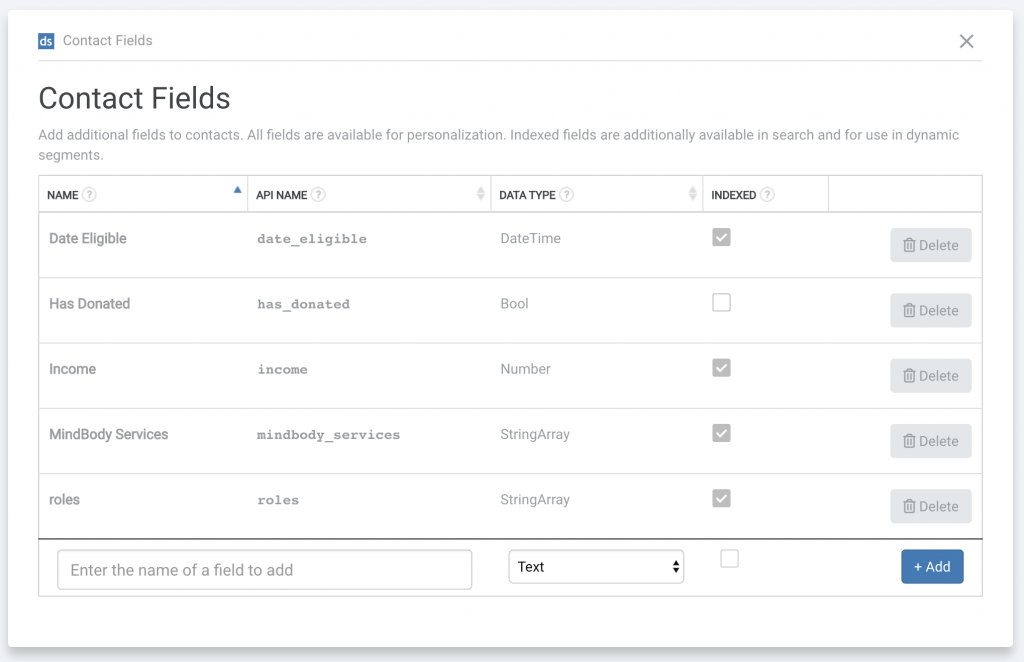A segment is a grouping of your audience who share common attributes. Segmentation helps you get the right message to the right people.
Examples of segments include people in a 30-day trial who have not completed a purchase or customers whose membership expires next month.
Once you identify a segment, you can target the segment with specific messages using the channels most appropriate for that segment. And, using personalization, content is uniquely targeted at each individual.
The end result is each person receives content targeted and personalized to them, through the channel (email, text messaging, push notification, etc.) most appropriate to them.
Sounds great. But where do you start? With data.
Collecting customer data
You have more data than you realize and countless untapped opportunities to collect it. One of the biggest challenges we see with our customers is how to aggregate customer and prospect data together.
Aggregating data from multiple systems and applications is not easy, but when done, doing so creates a rich trove of data for segmentation.
Customer segmentation data sources may include:
- Basic demographic data: age, gender, title and more
- Website activity: What pages did the customer visit?
- Past purchase history: What purchases has the customer made previously, such as memberships from Mindbody.
- Submitted form data: What data has the customer submitted through forms?
- Sales profiles: Information obtained from systems, such as Salesforce (for example)
- Mobile app engagement: Data from mobile app usage
- Customer location: What time zone is the customer in?
- Customer communities or other applications: Pulling data from sources such as a Telligent community or other customer management systems.
And those are just some examples! In addition to the data you have, you can also augment data from external sources.
Enrich customer data
In addition to the data you already have about your customers, this data can be enriched.
Examples include:
- Converting addresses to geographic latitude and longitude for proximity-based groupings, such as people within so many miles or kilometers of a location
- Average income and home value groupings (by using public and private sources this data can be derived from geographic information)
Building customer profiles
Now that you have some customer data, what do you do with it? How do you consolidate all the data into a unified customer profile?
DailyStory solves this by enabling you to extend DailyStory’s built-in customer profile.
For example, adding custom fields to your contacts, such as Membership Level, Expiration Date, Customer Groups and any other data type you can think of:

Next, you can update DailyStory contacts simply by uploading a spreadsheet. Including your own customer profile data.
While these two concepts aren’t unique to DailyStory, the ability for any customer profile data to be used for segment creation is unique. And, for those segments to automatically update themselves as data changes using Dynamic Segments.
Once you have your customer data aggregated together, you can start building your segments.
Building Segments
We recommend starting with large, “macro,” segments of your audience. Then, build smaller “hyper” segments.
What’s the difference?
Macro segments
Just as it sounds, a macro segment is a large segment, such as millennials, previous customers, current customers, customers in the U.S., people who use your mobile app, customers in Washington state and so on.
Macro segments describe a large group of your audience.
A macro segment typically represents about 10 percent to 30 percent of your total audience base.
For example, if there were 10,000 contacts in our list, we would expect 1,000 to 3,000 to be customers or previous customers.
Once you have established your macro segments, you’ll want to build smaller hyper segments.
Hyper segments
A hyper segment is a much smaller group and typically combines multiple macro segments along with other criteria.
An example of a hyper segment is millennials living within 5 miles of New York City that are previous customers.
Whereas a macro segment represents 10 percent to 30 percent of your total audience base, a hyper segment should represent about 5 percent or less.
For example, if there were 10,000 contacts in our list, we would expect 300 to 500 people to fit into a hyper segment.
Why are hyper segments so narrow?
Hyper segments are purposefully narrowly targeted.
Because the target audience is so specific, using personalization along with the most appropriate channel and message yields a higher engagement rate.
You can measure your overall engagement rate through opens, click and conversions.
Fit the channel to the audience
In marketing-speak, we say “channel” in reference to how we’re delivering our message: email, text messaging and push notifications are several examples.
- Push Notifications: Messages sent to people who installed your app. The message size is limited but represents an engaged audience.
- Text Messages: Messages sent to people for whom you have both a mobile number and have opted-in to receiving text messages from you. Similar to push notifications, the message size is limited, but text messages see a much higher engagement rate than email.
- Emails: Messages sent to people who have opted-in to receive emails.
When it comes to channel selection, use push notifications first (when/if available). When targeting younger audiences, use text messages. And email is the constant fallback if no other channel is available.
Once you select the appropriate channel, personalize the content to better target the recipient.
Personalization and content targeting
Personalization is your ability to use the data you have about your audience to understand how your content best fits their needs or interest. This ensures visitors and customers get messaging tailored to them.
In DailyStory, any profile field (including custom fields) are available for personalization. This includes basic personalization, such as addressing the recipient by his or her first name, or more complex personalization that selectively includes content.
The primary purpose of personalization is to make the message as targeted and as relevant to the recipient as possible. It goes hand-in-hand with the power of segmentation.
The more personalized your content, the higher the engagement rate you will see.
In conclusion
Properly segmenting your audience, choosing the most appropriate channels and personalizing your content will yield higher engagement rates. As an example, one of our customers achieved a more than 40 percent open rate on a campaign that used these techniques.
As you’re exploring audience segmentation strategies, consider leveling up your digital marketing with DailyStory. Features include automating various marketing tasks, dynamic audience segmentation and more. Schedule your free demo with us today.

